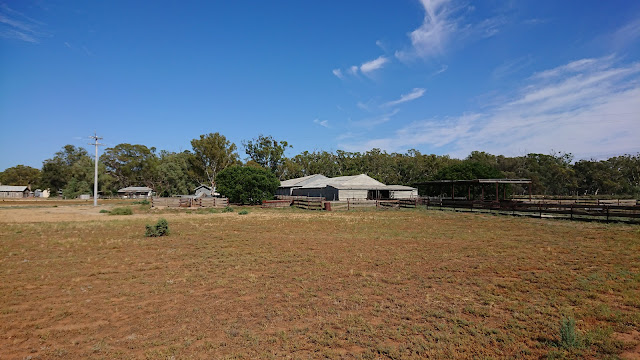There is something to be said for the humble motel. No matter how you try to spruce them up, the pre-eighties trimmings will always show up somewhere. You cannot delude yourself that you are in a luxury hotel.
But the ability to park your car right in front of your room and not deal with narrow basement carparks makes up for that and more.
So we just stuff our bags into the boot and B drove us out of Hay and off towards Adelaide. The land is so flat, salt bush and scrub, stretching out to distant horizons where mirages shimmer. Khaki, grey and gold beneath a brilliant blue sky. It is difficult to believe that I ever found it boring.
We stop at Balranald, on the Murrumbidgee River. The tourist information centre has a sign saying they will open at 9.45. They don't.
We partially retrace our route and turn off towards the Yanga Woolshed. A brown-grey snake slithers across the gravel road ahead of us, a warning to watch our step when we get out.
The dusty carpark is empty of any other visitors, except for the ever present flies. We should have ignored the entry sign and taken the other path towards the woolshed, as that way we would have seen the interpretive signs first.
The long timber and tin roof shearing shed still smelled strongly of sheep, despite its disuse, bringing back memories of farm stays as a child.
At the far end are explanations of the history of sheep shearing technology in Australia, including the powered shears and the wool press.
Further along are more displays about the history and environment of the region, including the labour shortages caused by the gold rush and the differences made by the riverboats that once plied the Murray, Darling and Murrumbidgee rivers.
According to a display overlooking the latter river, these waterways date back 60 million years and once drained into an inland sea.
The riverboat trade has long ceased, replaced by the train, which itself was replaced by the truck and car, the tool were are using today.
But the river network will still play a major role in today's journey.
We leave Balranald for Mildura, first driving alongside, then crossing the River Murray into Victoria. The landscape changes, with more low trees and redder dirt.
Mildura, a city I have fond memories of on my own, serves as an unsatisfying lunch and fuel stop. I swap with B for the drivers seat and take us all the way to Adelaide.
The soil of the Mallee Country is red dust and there are drifts of it intersecting with the edge of the road. It feels like Mars, but with low scrub. Near the few towns are orchards, mainly oranges edge with the olives that bely the origins of many farming families.
Twice on today's drive we encounter traffic lights in the middle of nowhere as roads are resurfaced.
Then the landscape turns a paler shade, though still dry. At the South Australian border is a checkpoint for fruits. Our car is inspected by the officer as authorities attempt to keep fruit fly out of the state.
Our route follows the Murray River for the next hundred kilometres. The river has carved a great valley through the dry landscape and we are driving high above it.
We stop at a lookout before Waikerie to gaze down at the river and then at the old bridge over Blanchetown.
Continuing on, we leave the Murray and enter the Barrossa Valley, with its famous wineries and golden rolling hills. The road splits into a four lane motorway, our first since leaving the Hume.
As we enter the outskirts of Adelaide parts of the motorway, which crosses salt lakes and industrial areas, is so new that it does not show up on the car's GPS navigation system. It is stressful and confusing, especially as we come to the city centre and need to turn off at intersections that no longer exist.
After one case of being horned, we eventually locate our destination, but my sense of direction is utterly scrambled.
We check in, then go out for a walk to find dinner. I set us off the wrong way, but the phone corrects me.
At the corner of a block we are surprised to see a shop straight out of Japan, selling pottery and groceries. We vow to return later.
Initially, we sit down at Kopi Tim, an old Malaysian restaurant. Then we decide to eat something else and go to a nearby Uyghur place. Unfortunately, there would be a long wait for their oven baked bread, so we make do with polo rice, laghman noodles and lamb skewers. It's okay, but not the best we have tasted.
Returning to Futake, we buy Lotte Coolish sachets of ice cream, a favourite treat from Japan.
I'm exhausted. Totally, utterly exhausted from the drive. We all decide to have a car free day for the next one as we collapse into our apartment. Three states in a day is a lot.













Comments